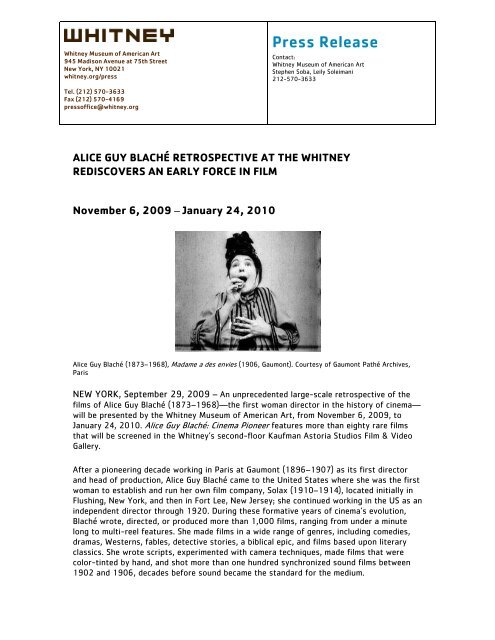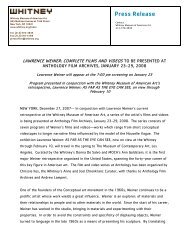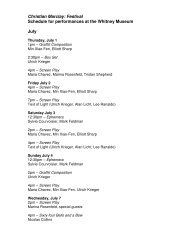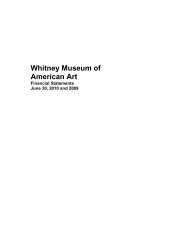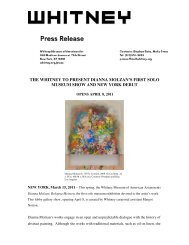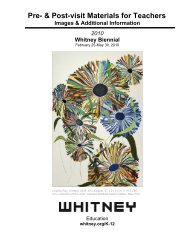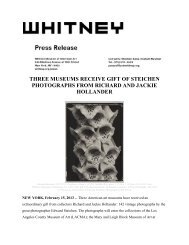Press Release - Whitney Museum of American Art
Press Release - Whitney Museum of American Art
Press Release - Whitney Museum of American Art
You also want an ePaper? Increase the reach of your titles
YUMPU automatically turns print PDFs into web optimized ePapers that Google loves.
<strong>Whitney</strong> <strong>Museum</strong> <strong>of</strong> <strong>American</strong> <strong>Art</strong><br />
945 Madison Avenue at 75th Street<br />
New York, NY 10021<br />
whitney.org/press<br />
Tel. (212) 570-3633<br />
Fax (212) 570-4169<br />
press<strong>of</strong>fice@whitney.org<br />
ALICE GUY BLACHÉ RETROSPECTIVE AT THE WHITNEY<br />
REDISCOVERS AN EARLY FORCE IN FILM<br />
November 6, 2009 – January 24, 2010<br />
<strong>Press</strong> <strong>Release</strong><br />
Contact:<br />
<strong>Whitney</strong> <strong>Museum</strong> <strong>of</strong> <strong>American</strong> <strong>Art</strong><br />
Stephen Soba, Leily Soleimani<br />
212-570-3633<br />
Alice Guy Blaché (1873–1968), Madame a des envies (1906, Gaumont). Courtesy <strong>of</strong> Gaumont Pathé Archives,<br />
Paris<br />
NEW YORK, September 29, 2009 – An unprecedented large-scale retrospective <strong>of</strong> the<br />
films <strong>of</strong> Alice Guy Blaché (1873–1968)—the first woman director in the history <strong>of</strong> cinema—<br />
will be presented by the <strong>Whitney</strong> <strong>Museum</strong> <strong>of</strong> <strong>American</strong> <strong>Art</strong>, from November 6, 2009, to<br />
January 24, 2010. Alice Guy Blaché: Cinema Pioneer features more than eighty rare films<br />
that will be screened in the <strong>Whitney</strong>’s second-floor Kaufman Astoria Studios Film & Video<br />
Gallery.<br />
After a pioneering decade working in Paris at Gaumont (1896–1907) as its first director<br />
and head <strong>of</strong> production, Alice Guy Blaché came to the United States where she was the first<br />
woman to establish and run her own film company, Solax (1910–1914), located initially in<br />
Flushing, New York, and then in Fort Lee, New Jersey; she continued working in the US as an<br />
independent director through 1920. During these formative years <strong>of</strong> cinema’s evolution,<br />
Blaché wrote, directed, or produced more than 1,000 films, ranging from under a minute<br />
long to multi-reel features. She made films in a wide range <strong>of</strong> genres, including comedies,<br />
dramas, Westerns, fables, detective stories, a biblical epic, and films based upon literary<br />
classics. She wrote scripts, experimented with camera techniques, made films that were<br />
color-tinted by hand, and shot more than one hundred synchronized sound films between<br />
1902 and 1906, decades before sound became the standard for the medium.
Until a decade ago, only forty <strong>of</strong> her films were known to exist; today, some 130 works<br />
have been identified in archives internationally. The recovery <strong>of</strong> Alice Guy Blaché’s work—<br />
both its identification as hers and its conservation and restoration—has involved an<br />
enormous worldwide undertaking by film historians, archivists, and preservationists.<br />
Joan Simon, the <strong>Whitney</strong>’s curator-at-large and organizer <strong>of</strong> the exhibition, notes: “Alice<br />
Guy Blaché—cinema’s first woman director, screenwriter, producer, businesswoman, and<br />
studio owner—is unique in film history. This exhibition introduces new audiences to a littleknown<br />
but historically key figure who had decade-long careers in France and the US, and<br />
affords film scholars a ‘critical mass’ <strong>of</strong> Blaché’s body <strong>of</strong> work by which to place her films<br />
within the international context <strong>of</strong> early cinema. Her films are important examples <strong>of</strong> film’s<br />
evolution as popular entertainment: they are bold, her stories fascinating, her point <strong>of</strong> view<br />
singular, her comedies raucous, and her characters (especially her women and child heroes)<br />
complex. Her career is worthy <strong>of</strong> renewed investigation and she deserves recognition as a<br />
pioneer <strong>of</strong> early cinema.”<br />
Born in Paris in 1873, and raised in Switzerland, Chile, and France, Alice Guy, as she then<br />
was known, studied the new “sciences” <strong>of</strong> typewriting and stenography, and began working<br />
as secretary to Léon Gaumont in 1894 at Le comptoir général de photographie, a<br />
manufacturer <strong>of</strong> still cameras and other optical equipment. This was the corporate<br />
predecessor <strong>of</strong> L. Gaumont & Cie, established in 1895, soon to become one <strong>of</strong> the world’s<br />
leading film companies and today the oldest in continuous operation. Guy learned the<br />
photography business through correspondence, familiarizing herself with clients, marketing,<br />
and the company’s stock <strong>of</strong> cameras, and became acquainted with the new technologies<br />
being invented for shooting and exhibiting motion pictures.<br />
Inventors Gaumont and the Lumière Brothers were friends as well as competitors; both were<br />
trying to solve the problem <strong>of</strong> projecting film. Alice Guy and Léon Gaumont were among the<br />
audience at a private screening in March 1895, when the Lumières presented their<br />
projection <strong>of</strong> a film <strong>of</strong> workers leaving a factory.<br />
Until this time at Gaumont, filmmaking had been in the service <strong>of</strong> science or used as a<br />
promotional tool for selling cameras. “In the beginning, everyone was always shooting<br />
street scenes, parades, or moving trains, which I did not find terribly interesting,” Guy later<br />
recalled. “So one day I said to Monsieur Gaumont: ‘It seems to me we could do something<br />
better.’” Perhaps with the courage <strong>of</strong> youth, Guy asked Gaumont if she could try making a<br />
film that would tell a story. He said yes. Thus, Alice Guy became Gaumont’s first director<br />
(although the term did not yet exist) and soon became head <strong>of</strong> production, spending the<br />
next decade making films at Gaumont’s studios in Paris and elsewhere in Europe, between<br />
1896 and 1907.<br />
Guy’s earliest films at Gaumont share certain subjects and visions with some <strong>of</strong> her<br />
colleagues, such as the Lumières. As Joan Simon writes in her catalogue essay, “The magical<br />
antics when body parts come undone from a body, as in Guy’s Chirurgie fin de siècle (Fin de<br />
Siècle Surgery, 1900), are in the spirit <strong>of</strong> Méliès’s famous and numerous deconstructions.<br />
She also, like many <strong>of</strong> her contemporaries, made travel films and dance films, sometimes the<br />
two genres conveyed in one moving picture, such as her dances filmed in Spain, particularly<br />
the beautiful hand-tinted films Le Bolero (1905), performed by Miss Saharet, and Tango<br />
(1905).”
Guy’s distinct point <strong>of</strong> view was to be seen in her story films, and she was among the first<br />
to make them. She worked from scripts, which she wrote as well as directed. Though she<br />
produced such typical period genres as chase films or those derived from fairy tales, these<br />
<strong>of</strong>ten featured a twist. The folktale <strong>of</strong> children born in a cabbage patch is the subject <strong>of</strong> her<br />
first film, La Fée aux choux (The Cabbage Fairy). In the story, babies are presented as if<br />
they are new cameras for sale. The theme <strong>of</strong> the complications <strong>of</strong> parenthood recurs in<br />
many <strong>of</strong> her films, whether La Fée Printemps (1906), in which a fairy magically transforms<br />
winter to spring and delivers a newborn from a garden to expectant parents, or Madame a<br />
des envies (Madame Has Cravings, 1906), a new kind <strong>of</strong> chase film, where a pregnant<br />
woman races through town, husband and child in tow, stealing foods to satisfy her cravings.<br />
Guy also addressed the duplicity and brutality <strong>of</strong> a stepmother (La Marâtre, 1906) and the<br />
same year made her epic La Vie du Christ, with sets and costumes based on the realist<br />
illustrations in a famous James Tissot bible, using some twenty-five sets and hundreds <strong>of</strong><br />
extras, for a film running ca. thirty-four minutes long, at a time when the norm was a<br />
maximum <strong>of</strong> six or seven minutes.<br />
Guy’s decade-long career at Gaumont alone would have earned her a place in cinema<br />
history. However, this was followed by a second decade in the United States, from 1910 to<br />
1920, where she was known as Madame Blaché (or Alice Blaché). Here she worked at her<br />
own company, Solax, which existed from 1910 to 1914, first in Flushing, New York, and<br />
later in Fort Lee, New Jersey (where she built a studio plant at a cost <strong>of</strong> $100,000), and<br />
subsequently as an independent for companies such as Metro and Pathé. While some <strong>of</strong> her<br />
<strong>American</strong> films explore genres new for the filmmaker, including detective stories and<br />
Westerns, others address in new ways themes she had already considered in France. Several<br />
Solax films continue her use <strong>of</strong> cross-dressing—Officer Henderson (1913), for example, in<br />
which undercover police dress in drag to pursue purse-snatchers—that was earlier<br />
employed to great comic effect in Les Résultats du féminisme (1906) to depict a world<br />
where male and female roles are reversed (the latter also re-told in her Solax film In Year<br />
2000, made in 1912, whereabouts unknown). Others again ponder the nuances, the<br />
difficulties, and the human comedy <strong>of</strong> domesticity, such as Mixed Pets (1911), in which<br />
neither baby nor dog is wanted in a household, or A House Divided (1913), in which a<br />
couple estranged by suspicions <strong>of</strong> infidelity must live together under one ro<strong>of</strong> and<br />
communicate exclusively by handwritten notes. She also continued to make films which<br />
feature child heroes and heroines, such as Falling Leaves (1911), as in the earlier Gaumont<br />
film Une Héroine de 4 ans (1907).<br />
Madame Blaché also addressed modern social problems in several <strong>of</strong> her films. The Making<br />
<strong>of</strong> an <strong>American</strong> Citizen (1912) is a story <strong>of</strong> immigration and relearning the expected roles <strong>of</strong><br />
husbands and wives. Other films explore prejudicial views toward the poor (The Thief,<br />
1913), and, in the case <strong>of</strong> A Fool and His Money (1912), the follies <strong>of</strong> social climbers and<br />
the well-<strong>of</strong>f. This last film is also significant for being the earliest known film to feature an<br />
all black cast.<br />
In her three surviving feature-length films, The Ocean Waif (1916), The Empress (1917),<br />
and The Great Adventure (1918), her leading women demonstrate increasing sophistication,<br />
finding their way by using their wits and with the help <strong>of</strong> some surprising comrades. Her<br />
characters (and relationships between characters) are psychologically complex, even as they<br />
play out the kind <strong>of</strong> melodramas that were becoming the standard in the industry at that<br />
time.
Alice Guy Blaché (the name she chose to use after her divorce and return to France in 1922)<br />
produced a singular body <strong>of</strong> work that spans the evolution <strong>of</strong> filmmaking on two continents.<br />
Her oeuvre in both her French and <strong>American</strong> periods reveals her to have been a gifted<br />
scriptwriter who transformed imagined picture-stories into motion pictures and a new kind<br />
<strong>of</strong> director who asked actors to “be natural.” She established the house style at Gaumont,<br />
trained its next generation <strong>of</strong> directors (including Ferdinand Zecca, Etienne Arnaud, Louis<br />
Feuillade), and then did the same at her US company, Solax. Her role as a studio owner is<br />
still rare in the film industry; among the few women who followed her were Mary Pickford<br />
and Lucille Ball.<br />
Although her moviemaking career ended in 1920, when she was only forty-seven years old,<br />
cinema occupied her whole life. She corresponded with historians and others, sharing<br />
documents with them, to correct early film histories that had not included her work. Well<br />
into her eighties, she gave lectures and was interviewed on radio and television about her<br />
roles in the nascent film industries <strong>of</strong> the US and France. In 1955, she was recognized with<br />
the Legion <strong>of</strong> Honor (France’s highest non-military honor), and in 1957 was honored by the<br />
Cinémathèque Française. The posthumous publication <strong>of</strong> her memoirs, first in French in<br />
1976 and then in English in 1986, with the assistance <strong>of</strong> film historian Anthony Slide,<br />
initiated an important cycle <strong>of</strong> rediscovery. In his catalogue essay, film historian Alan<br />
Williams calls Blaché’s memoirs “one <strong>of</strong> the very best books <strong>of</strong> its kind…a basic text in the<br />
history <strong>of</strong> early cinema.”<br />
This exhibition underscores the importance <strong>of</strong> film preservation in the study <strong>of</strong> early<br />
cinema. From the <strong>American</strong> portion <strong>of</strong> Madame Blaché’s career, five films that are in the<br />
collection <strong>of</strong> the Library <strong>of</strong> Congress have been restored by the <strong>Whitney</strong>, including the<br />
feature The Ocean Waif. Two others, also in the collection <strong>of</strong> the Library, have been<br />
restored by gift: Falling Leaves (1911), thanks to Dayton Digital Filmworks, and Mixed Pets<br />
(1911), with a grant from New York Women in Film and Television, Women’s Film<br />
Preservation Fund and contributions by the <strong>Whitney</strong>. The occasion <strong>of</strong> this exhibition has<br />
been the catalyst for other archives to begin to restore films in their collections, including<br />
the Academy Film Archive-Center for Motion Picture Study, Los Angeles; BFI, London; and<br />
the Filmoteca Española, Madrid.<br />
Detailed daily screening information will be available on whitney.org. To<br />
accommodate requirements for limited screenings <strong>of</strong> archival film material and also allow<br />
wider access to these films, for the twelve Sundays and select Friday evenings during the<br />
exhibition’s run, special 35mm projections will take place, many <strong>of</strong> them with live musical<br />
accompaniment. The weekly screenings will be shown in other formats, including beta-sp<br />
and HD. A selection <strong>of</strong> Guy’s synchronized sound films will be screened and heard; several<br />
suites <strong>of</strong> silent films will be accompanied by recorded scores by contemporary composers<br />
Du Yun, Missy Mazzoli, Tamar Muskal, and Tender Forever—commissioned by <strong>Whitney</strong> Live<br />
and the French Institute Alliance Française—and by Barbara Harbach.<br />
Catalogue<br />
The <strong>Whitney</strong>’s exhibition <strong>of</strong> the films <strong>of</strong> Alice Guy Blaché is accompanied by an illustrated<br />
catalogue (fifty-nine black-and-white images; eight-page color section) published by Yale<br />
University <strong>Press</strong>, in association with the <strong>Whitney</strong> <strong>Museum</strong> <strong>of</strong> <strong>American</strong> <strong>Art</strong>, with<br />
contributions by noted film scholars Jane Gaines, Alison McMahan, Charles Musser, Alan
Williams, film historian and preservationist Kim Tomadjoglou, and the show’s organizer,<br />
Joan Simon.<br />
Alice Guy Blaché Film Score Project: A <strong>Whitney</strong> Live Commission in Partnership with<br />
the French Institute Alliance Française<br />
<strong>Whitney</strong> Live, the <strong>Whitney</strong>’s performance series, has commissioned scores by four vanguard<br />
women composers—Du Yun, Missy Mazzoli, Tamar Muskal, and Tender Forever—for four<br />
Alice Guy Blaché film programs. The commissioned-score project is a partnership between<br />
the <strong>Whitney</strong> and the French Institute Alliance Française; the recorded scores will be heard<br />
with the films during the run <strong>of</strong> the <strong>Whitney</strong> exhibition and will be premiered in live<br />
performance, along with the projected films, at Florence Gould Hall, 55 East 59th Street, on<br />
September 29th as part <strong>of</strong> FIAF’s 2009 multimedia “Crossing the Line” festival. For more<br />
information, go to fiaf.org or call (212) 355-6160. Tickets may be purchased at fiaf.org or<br />
by calling Ticketmaster at (212) 307-4100.<br />
Other Special Events<br />
Saturday, November 14, 2009, 9:30 am-5 pm: “Woman with a Movie Camera: Alice Guy<br />
Blaché Symposium,” co-sponsored by the <strong>Whitney</strong>’s Education Department and the<br />
Department <strong>of</strong> Cinema Studies, Tisch School <strong>of</strong> the <strong>Art</strong>s, New York University. At the Iris &<br />
B. Gerald Cantor Film Center, New York University, 36 East 8th Street, New York.<br />
Friday, December 4, 2009, at 7 pm: “Film Evening Honoring the Women’s Film<br />
Preservation Fund (WFPF) <strong>of</strong> New York Women in Film and Television.” A special screening<br />
<strong>of</strong> four <strong>of</strong> Guy Blaché’s Solax films (Mixed Pets, 1911; A Fool and His Money, 1912; A<br />
House Divided, 1913; and Matrimony’s Speed Limit, 1913), restored by the WFPF, New York<br />
Women in Film and Television. Drake Stutesman (editor, Framework: The Journal <strong>of</strong> Cinema<br />
and Media) will introduce the evening; the screening will be followed by a conversation with<br />
Diana Little (preservationist, Cineric) and Mona Jimenez (cinema studies pr<strong>of</strong>essor and<br />
associate director <strong>of</strong> NYU’s Moving Image Archiving and Preservation program). At the<br />
<strong>Whitney</strong> <strong>Museum</strong> <strong>of</strong> <strong>American</strong> <strong>Art</strong>.<br />
Saturday, December 5, 2009, 5:30-6:30 pm: Special Screening <strong>of</strong> Alice Guy’s La Vie du<br />
Christ (1906) at the Brooklyn <strong>Museum</strong>. Presented in conjunction with the exhibition James<br />
Tissot: The Life <strong>of</strong> Christ (October 23, 2009-January 2010), organized by Judith F. Dolkart<br />
and made possible in part with support from the National Endowment for the <strong>Art</strong>s. Alice<br />
Guy based the twenty-five sets and costumes for her silent film epic La Vie du Christ (The<br />
Life <strong>of</strong> Christ) on illustrations from Tissot’s watercolors published as the so-called Tissot<br />
Bible, a turn-<strong>of</strong>-the-century bestseller in England, France, and the US. The Brooklyn<br />
<strong>Museum</strong> exhibition includes 124 selected from the complete set <strong>of</strong> 350, as well as a copy<br />
<strong>of</strong> the Tissot Bible. The original watercolors were a pivotal acquisition <strong>of</strong> the Brooklyn<br />
<strong>Museum</strong> in 1900, the year Alice Guy herself acquired a copy <strong>of</strong> the Tissot Bible in Paris.<br />
This screening, a partnership between the <strong>Whitney</strong> and the Brooklyn <strong>Museum</strong>, affords<br />
visitors a chance to compare the mediums <strong>of</strong> painting (and its translation into printed<br />
images) and film as related narrative forms. Following the screening will be a discussion<br />
comparing and contrasting the points <strong>of</strong> view <strong>of</strong> filmmaker and painter, led by Judith F.<br />
Dolkart, Associate Curator, European <strong>Art</strong>, Brooklyn <strong>Museum</strong>, and curator <strong>of</strong> the Tissot<br />
exhibition; Catherine Morris, Curator, Elizabeth A. Sackler Center for Feminist <strong>Art</strong>, Brooklyn<br />
<strong>Museum</strong>; Joan Simon, <strong>Whitney</strong> curator-at-large and organizer <strong>of</strong> the Alice Guy Blaché<br />
exhibition. For more information, visit brooklynmuseum.org. Presented as part <strong>of</strong> Target
First Saturdays at the Brooklyn <strong>Museum</strong>. The Brooklyn <strong>Museum</strong>, Iris and B. Gerald Cantor<br />
Auditorium, 200 Eastern Parkway, Brooklyn, NY. By subway: 2/3 train to Eastern<br />
Parkway/Brooklyn <strong>Museum</strong> station.<br />
Alice Guy Blaché: Cinema Pioneer is sponsored, in part, by <strong>American</strong> Express<br />
Generous support is provided by Jessica E. Smith and Kevin R. Brine.<br />
Significant support is provided by the Elizabeth A. Sackler <strong>Museum</strong> Educational Trust, the Audrey<br />
and Sydney Irmas Foundation, and an anonymous foundation donor.<br />
Special support provided by the Academy <strong>of</strong> Motion Picture <strong>Art</strong>s and Sciences.<br />
About the <strong>Whitney</strong><br />
The <strong>Whitney</strong> <strong>Museum</strong> <strong>of</strong> <strong>American</strong> <strong>Art</strong> is the leading advocate <strong>of</strong> 20th- and 21st-century <strong>American</strong><br />
art. Founded in 1930, the <strong>Museum</strong> is regarded as the preeminent collection <strong>of</strong> <strong>American</strong> art and<br />
includes major works and materials from the estate <strong>of</strong> Edward Hopper, the largest public collection<br />
<strong>of</strong> works by Alexander Calder, as well as significant works by Jasper Johns, Donald Judd, Agnes<br />
Martin, Bruce Nauman, Georgia O'Keeffe, Claes Oldenburg, Kiki Smith, and Andy Warhol, among other<br />
artists. With its history <strong>of</strong> exhibiting the most promising and influential <strong>American</strong> artists and<br />
provoking intense critical and public debate, the <strong>Whitney</strong>'s signature show, the Biennial, has become<br />
the most important survey <strong>of</strong> the state <strong>of</strong> contemporary art in America today. First housed on West<br />
8th Street, the <strong>Whitney</strong> relocated in 1954 to West 54th Street and in 1966 inaugurated its present<br />
home at 945 Madison Avenue, designed by Marcel Breuer. The <strong>Whitney</strong> is currently moving ahead<br />
with plans to build a second facility, designed by Renzo Piano, located in downtown New York at the<br />
entrance to the High Line in the Meatpacking District.<br />
Current and Upcoming Exhibitions at the <strong>Whitney</strong> <strong>Museum</strong> <strong>of</strong> <strong>American</strong> <strong>Art</strong>:<br />
Dan Graham: Beyond Through October 11, 2009<br />
Georgia O’Keeffe: Abstraction Through January 17, 2010<br />
A Few Frames: Photography and the Contact Sheet Through January 3, 2010<br />
Steve Wolfe on Paper September 30-November 29, 2009<br />
Roni Horn aka Roni Horn November 6, 2009-January 24, 2010<br />
Alice Guy Blaché: Cinema Pioneer November 6, 2009-January 24, 2010<br />
The <strong>Whitney</strong> <strong>Museum</strong> is located at 945 Madison Avenue, New York City. <strong>Museum</strong> hours are:<br />
Wednesday, Thursday, Saturday, and Sunday from 11 a.m. to 6 p.m., Friday from 1 p.m. to 9<br />
p.m., closed Monday and Tuesday. Admission is $15 for adults; Members, children (ages 11 and<br />
under), and New York City public high school students free. Senior citizens (62 and over) and<br />
students with valid ID: $10. There is a $6 admission fee for a pass to the Kaufman Astoria<br />
Studios Film & Video Gallery only. Admission is pay-what-you-wish on Fridays, 6-9 pm. For<br />
information, please call 212-570-3600 or visit whitney.org


